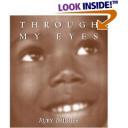Through My Eyes
- Author: Ruby Bridges
- Publisher and date: Scholastic, 1999
- Genres: autobiography
- Ages 6- and up
Author’s perspective: Ruby Brigdes tells her own story. She has an insider’s perspective.
Literary Elements:
Style: The photographs and snippets of articles give a deeper understanding for students. The kids in my class truly start to understand that Ruby is a real person. Some of the photographs are very intense.
Tone:Ruby tells her own story. She tells how she felt at the time, and also adds information that she has learned as an adult. This book combines nicely with The Story of Ruby Bridges. We now see the events through her own perspective.
Summary:
Ruby tells her own story, in her own words. She shares the thoughts and feelings she had as a six year old, combined with a perspective that she has now as an adult who feels privileged to have been a part of changing the world. Her words are accompanied by period photographs, comments by others from her life, and news and magazine articles.
Curriculum Connections:
I mostly use this book for the photographs of the time period. It helps to further empasize to the children that Ruby and her story really happened. Children often flock to this book during free book time and pour over the photographs together. I have the small, paperback copy from Scholastic. Our school library has a hard cover version which I believe is larger.
Time line of major events in the civil rights movement on page 55.
Also see information under The Story of Ruby Bridges
Web Resources:
Review:
From Publishers Weekly
With Robert Coles’s 1995 picture book, The Story of Ruby Bridges, and a Disney television movie, readers may feel they already know all about Bridges, who in 1960 was the first black child to attend a New Orleans public elementary school. But the account she gives here is freshly riveting. With heartbreaking understatement, she gives voice to her six-year-old self. Escorted on her first day by U.S. marshals, young Ruby was met by throngs of virulent protesters (“I thought maybe it was Mardi Gras… Mardi Gras was always noisy,” she remembers). Her prose stays unnervingly true to the perspective of a child: “The policeman at the door and the crowd behind us made me think this was an important place. It must be college, I thought to myself.” Inside, conditions were just as strange, if not as threatening. Ruby was kept in her own classroom, receiving one-on-one instruction from teacher Barbara Henry, a recent transplant from Boston. Sidebars containing statements from Henry and Bridges’s mother, or excerpts from newspaper accounts and John Steinbeck’s Travels with Charley, provide information and perspectives unavailable to Bridges as a child. As the year went on, Henry accidentally discovered the presence of other first graders, and she had to force the principal to send them into her classroom for part of the day (the principal refused to make the other white teachers educate a black child). Ironically, it was only when one of these children refused to play with Ruby (“My mama said not to because you’re a nigger”) that Ruby realized that “everything had happened because I was black…. It was all about the color of my skin.” Sepia-toned period photographs join the sidebars in rounding out Bridges’s account. But Bridges’s words, recalling a child’s innocence and trust, are more vivid than even the best of the photos. Like poetry or prayer, they melt the heart. Ages 8-12. (Sept.)
Copyright 1999 Reed Business Information, Inc.
From Library Journal
Grade 4-7-Profusely illustrated with sepia photos-including many gritty journalistic reproductions-this memoir brings some of the raw emotions of a tumultuous period into sharp focus. In her recounting of the events of 1960-61, the year she became the first African-American child to integrate the William Frantz Elementary School in New Orleans, Bridges is true to her childhood memories. She is clear about what she remembers and what she later learned. Her account is accompanied by excerpts from newspaper articles, comments by her teacher, and a time line that fill in the details and place her story within the context of the Civil Rights Movement. The narrative draws a distinct contrast between the innocence of this six-year-old child who thought that “Two, four, six, eight, we don’t want to integrate” was a jump-rope chant and the jeers of the angry crowd outside her school carrying a black doll in a coffin. A powerful personal narrative that every collection will want to own.
Daryl Grabarek, School Library Journal
Copyright 1999 Reed Business Information, Inc.
